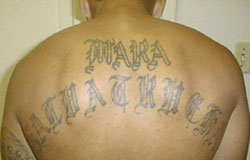This article's factual accuracy may be compromised due to out-of-date information.(April 2025) |
Crime in El Salvador was historically high due to the presence of various gangs. In 2011, there were an estimated 25,000 gang members at large in El Salvador; with another 43,500 in prison. [1] The best-known gangs, called maras in colloquial Salvadoran Spanish, are Mara Salvatrucha (MS-13) and their rivals 18th Street; maras are hunted by death squads, including Sombra Negra . Newer rivals include the rising mara, The Rebels 13. [2] El Salvador is one of the three countries of the Northern Triangle of Central America, along with neighboring Guatemala and Honduras, which are all afflicted with high levels of violence. [3]
Contents
- History of violence in El Salvador
- El Salvador homicides
- Gangs
- Gangs and violence
- Reasons for joining gangs
- Links to drug trafficking
- Migration and Displacement
- Efforts to reduce violence
- Government policy
- Gang truce
- Non-government groups
- Impact on youth
- During the War
- Gang involvement
- Women in gangs
- Unaccompanied minors fleeing El Salvador
- Asylum opportunities in other countries
- Region specific
- San Salvador
- Homicide by municipality (2009–2014)
- See also
- References
- External links

The homicide rate in El Salvador has plummeted drastically since 2015. The Salvadoran gang crackdown has led El Salvador to have the highest incarceration rate in the world, at 1,086 people per 100,000 in 2023. In 2023, an estimated 1.6% of El Salvador's population was incarcerated. [4]
Since 2022, due to the crackdown, El Salvador's crime rate sharply dropped, making it the safest country in Central America. [5]

